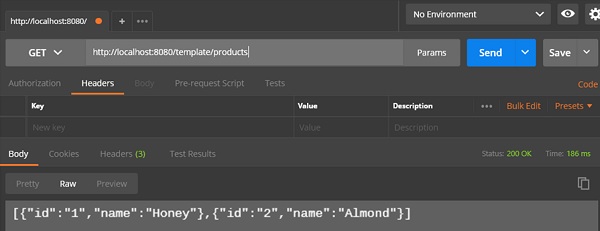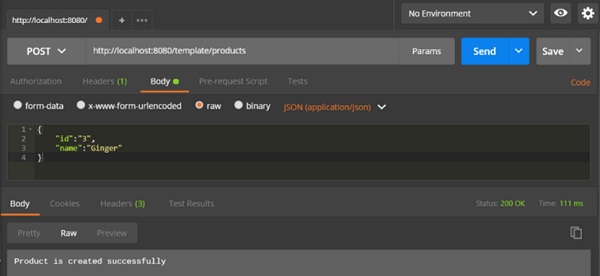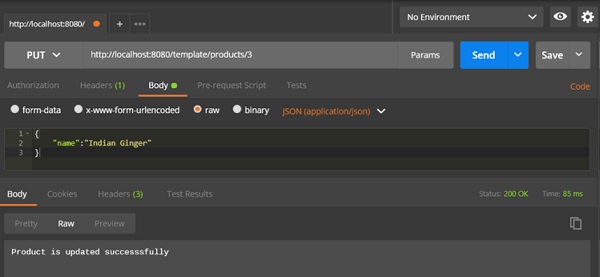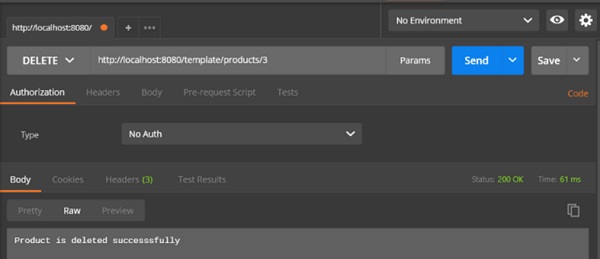- 入门教程
- AOP教程
- 数据库教程
- 缓存教程

Rest模板用于创建使用RESTful Web服务的应用程序,您可以使用 exchange()方法为所有HTTP方法使用Web服务。
package com.learnfk.demo; import org.springframework.boot.SpringApplication; import org.springframework.boot.autoconfigure.SpringBootApplication; import org.springframework.context.annotation.Bean; import org.springframework.web.client.RestTemplate; @SpringBootApplication public class DemoApplication { public static void main(String[] args) { SpringApplication.run(DemoApplication.class, args); } @Bean public RestTemplate getRestTemplate() { return new RestTemplate(); } }
GET 请求
使用RestTemplate消耗GET API-exchange()方法
假设此URL http:// localhost:8080/products 返回以下JSON,无涯教程将通过使用Rest Template使用以下代码来使用此API响应-
[ { "id": "1", "name": "Honey" }, { "id": "2", "name": "Almond" } ]
您将必须遵循给定的点来使用API-
- Autowired - Rest模板对象。
- HttpHeaders - 设置请求标头。
- HttpEntity - 包装请求对象。
- 为Exchange()方法提供URL,HttpMethod和返回类型。
@RestController public class ConsumeWebService { @Autowired RestTemplate restTemplate; @RequestMapping(value = "/template/products") public String getProductList() { HttpHeaders headers = new HttpHeaders(); headers.setAccept(Arrays.asList(MediaType.APPLICATION_JSON)); HttpEntity <String> entity = new HttpEntity<String>(headers); return restTemplate.exchange(" http://localhost:8080/products", HttpMethod.GET, entity, String.class).getBody(); } }
POST 请求
使用RestTemplate使用POST API-exchange()方法
假设此URL http://localhost:8080/products 返回以下所示的响应,无涯教程将通过使用Rest模板使用此API响应。
下面给出的代码是Request主体-
链接:https://www.learnfk.comhttps://www.learnfk.com/spring-boot/spring-boot-rest-template.html
来源:LearnFk无涯教程网
{ "id":"3", "name":"Ginger" }
下面给出的代码是Response主体-
Product is created successfully
您必须遵循以下要点才能使用API-
Autowired - Rest模板对象。
HttpHeaders - 设置请求标头。
HttpEntity - 包装请求对象,在这里包装了Product对象,以将其发送到请求正文。
为exchange()方法提供URL,HttpMethod和Return类型。
@RestController public class ConsumeWebService { @Autowired RestTemplate restTemplate; @RequestMapping(value = "/template/products", method = RequestMethod.POST) public String createProducts(@RequestBody Product product) { HttpHeaders headers = new HttpHeaders(); headers.setAccept(Arrays.asList(MediaType.APPLICATION_JSON)); HttpEntity<Product> entity = new HttpEntity<Product>(product,headers); return restTemplate.exchange( "http://localhost:8080/products", HttpMethod.POST, entity, String.class).getBody(); } }
PUT 请求
使用RestTemplate消费PUT API-exchange()方法
假定此URL http:// localhost:8080/products/3 返回以下响应,将通过使用Rest Template使用此API响应。
下面给出的代码是Request body-
{ "name":"Indian Ginger" }
下面给出的代码是Response主体-
Product is updated successfully
您必须遵循以下要点才能使用API-
Autowired - Rest模板对象。
HttpHeaders - 设置请求标头。
HttpEntity - 包装请求对象。在这里,无涯教程包装了Product对象,以将其发送到请求正文。
为exchange()方法提供URL,HttpMethod和Return类型。
@RestController public class ConsumeWebService { @Autowired RestTemplate restTemplate; @RequestMapping(value = "/template/products/{id}", method = RequestMethod.PUT) public String updateProduct(@PathVariable("id") String id, @RequestBody Product product) { HttpHeaders headers = new HttpHeaders(); headers.setAccept(Arrays.asList(MediaType.APPLICATION_JSON)); HttpEntity<Product> entity = new HttpEntity<Product>(product,headers); return restTemplate.exchange( "http://localhost:8080/products/"+id, HttpMethod.PUT, entity, String.class).getBody(); } }
DELETE 请求
使用RestTemplate消耗DELETE API-exchange()方法
假设此URL http:// localhost:8080/products/3 返回以下给出的响应,将通过使用Rest Template使用此API响应。
下面显示的这一行代码是Response主体-
Product is deleted successfully
您将必须遵循以下要使用API的要点-
Autowired - Rest模板对象。
HttpHeaders - 设置请求标头。
HttpEntity - 包装请求对象。
为exchange()方法提供URL,HttpMethod和Return类型。
@RestController public class ConsumeWebService { @Autowired RestTemplate restTemplate; @RequestMapping(value = "/template/products/{id}", method = RequestMethod.DELETE) public String deleteProduct(@PathVariable("id") String id) { HttpHeaders headers = new HttpHeaders(); headers.setAccept(Arrays.asList(MediaType.APPLICATION_JSON)); HttpEntity<Product> entity = new HttpEntity<Product>(headers); return restTemplate.exchange( "http://localhost:8080/products/"+id, HttpMethod.DELETE, entity, String.class).getBody(); } }
完整的Rest Template Controller类文件在下面给出-
package com.learnfk.demo.controller; import java.util.Arrays; import org.springframework.beans.factory.annotation.Autowired; import org.springframework.http.HttpEntity; import org.springframework.http.HttpHeaders; import org.springframework.http.HttpMethod; import org.springframework.http.MediaType; import org.springframework.web.bind.annotation.PathVariable; import org.springframework.web.bind.annotation.RequestBody; import org.springframework.web.bind.annotation.RequestMapping; import org.springframework.web.bind.annotation.RequestMethod; import org.springframework.web.bind.annotation.RestController; import org.springframework.web.client.RestTemplate; import com.learnfk.demo.model.Product; @RestController public class ConsumeWebService { @Autowired RestTemplate restTemplate; @RequestMapping(value = "/template/products") public String getProductList() { HttpHeaders headers = new HttpHeaders(); headers.setAccept(Arrays.asList(MediaType.APPLICATION_JSON)); HttpEntity<String> entity = new HttpEntity<String>(headers); return restTemplate.exchange( "http://localhost:8080/products", HttpMethod.GET, entity, String.class).getBody(); } @RequestMapping(value = "/template/products", method = RequestMethod.POST) public String createProducts(@RequestBody Product product) { HttpHeaders headers = new HttpHeaders(); headers.setAccept(Arrays.asList(MediaType.APPLICATION_JSON)); HttpEntity<Product> entity = new HttpEntity<Product>(product,headers); return restTemplate.exchange( "http://localhost:8080/products", HttpMethod.POST, entity, String.class).getBody(); } @RequestMapping(value = "/template/products/{id}", method = RequestMethod.PUT) public String updateProduct(@PathVariable("id") String id, @RequestBody Product product) { HttpHeaders headers = new HttpHeaders(); headers.setAccept(Arrays.asList(MediaType.APPLICATION_JSON)); HttpEntity<Product> entity = new HttpEntity<Product>(product,headers); return restTemplate.exchange( "http://localhost:8080/products/"+id, HttpMethod.PUT, entity, String.class).getBody(); } @RequestMapping(value = "/template/products/{id}", method = RequestMethod.DELETE) public String deleteProduct(@PathVariable("id") String id) { HttpHeaders headers = new HttpHeaders(); headers.setAccept(Arrays.asList(MediaType.APPLICATION_JSON)); HttpEntity<Product> entity = new HttpEntity<Product>(headers); return restTemplate.exchange( "http://localhost:8080/products/"+id, HttpMethod.DELETE, entity, String.class).getBody(); } }
下面给出了Spring Boot应用程序类– DemoApplication.java的代码-
package com.learnfk.demo; import org.springframework.boot.SpringApplication; import org.springframework.boot.autoconfigure.SpringBootApplication; @SpringBootApplication public class DemoApplication { public static void main(String[] args) { SpringApplication.run(DemoApplication.class, args); } }
下面给出了Maven构建的代码– pom.xml-
<?xml version = "1.0" encoding = "UTF-8"?> <project xmlns = "http://maven.apache.org/POM/4.0.0" xmlns:xsi = "http://www.w3.org/2001/XMLSchema-instance" xsi:schemaLocation = "http://maven.apache.org/POM/4.0.0 http://maven.apache.org/xsd/maven-4.0.0.xsd"> <modelVersion>4.0.0</modelVersion> <groupId>com.learnfk</groupId> <artifactId>demo</artifactId> <version>0.0.1-SNAPSHOT</version> <packaging>jar</packaging> <name>demo</name> <description>Demo project for Spring Boot</description> <parent> <groupId>org.springframework.boot</groupId> <artifactId>spring-boot-starter-parent</artifactId> <version>1.5.8.RELEASE</version> <relativePath/> </parent> <properties> <project.build.sourceEncoding>UTF-8</project.build.sourceEncoding> <project.reporting.outputEncoding>UTF-8</project.reporting.outputEncoding> <java.version>1.8</java.version> </properties> <dependencies> <dependency> <groupId>org.springframework.boot</groupId> <artifactId>spring-boot-starter-web</artifactId> </dependency> <dependency> <groupId>org.springframework.boot</groupId> <artifactId>spring-boot-starter-test</artifactId> <scope>test</scope> </dependency> </dependencies> <build> <plugins> <plugin> <groupId>org.springframework.boot</groupId> <artifactId>spring-boot-maven-plugin</artifactId> </plugin> </plugins> </build> </project>
下面给出了Gradle Build – build.gradle的代码-
buildscript { ext { springBootVersion = '1.5.8.RELEASE' } repositories { mavenCentral() } dependencies { classpath("org.springframework.boot:spring-boot-gradle-plugin:${springBootVersion}") } } apply plugin: 'java' apply plugin: 'eclipse' apply plugin: 'org.springframework.boot' group = 'com.learnfk' version = '0.0.1-SNAPSHOT' sourceCompatibility = 1.8 repositories { mavenCentral() } dependencies { compile('org.springframework.boot:spring-boot-starter-web') testCompile('org.springframework.boot:spring-boot-starter-test') }
您可以创建一个可执行的JAR文件,并使用以下Maven或Gradle命令运行Spring Boot应用程序-
对于Maven,您可以使用下面给出的命令-
mvn clean install在" BUILD SUCCESS"之后,您可以在目标目录下找到JAR文件。
对于Gradle,您可以使用下面显示的命令-
gradle clean build在" BUILD SUCCESSFUL"之后,您可以在build/libs目录下找到JAR文件。
现在,使用以下命令运行JAR文件:
java –jar <JARFILE>
现在,该应用程序已在Tomcat端口8080上启动。

现在,在POSTMAN应用程序中单击下面的URL,您可以看到输出。
按其余模板获取产品- http:// localhost:8080/template/products

创建产品POST- http:// localhost:8080/template/products

更新产品PUT- http:// localhost:8080/template/products/3

删除产品- http:// localhost:8080/template/products/3

祝学习愉快!(内容编辑有误?请选中要编辑内容 -> 右键 -> 修改 -> 提交!)
 《Spring Boot入门教程》
《Spring Boot入门教程》 